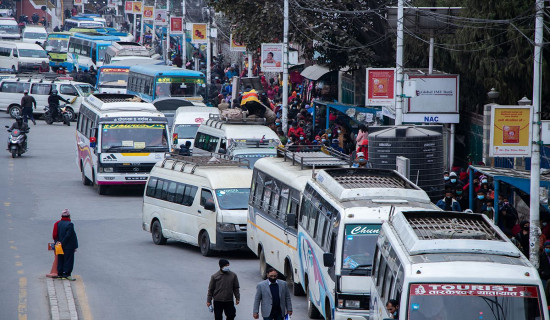- Thursday, 22 January 2026
Reimagining New Road With Vibrant Future
New Road, a central and iconic marketplace in Kathmandu, has long been a bustling hub of commerce and culture. Established in the mid-20th century, this street has witnessed the city's evolution from a quiet town to a sprawling metropolis. Over the decades, New Road has become synonymous with urban life in Kathmandu, reflecting both the vibrancy and the challenges of modern city life. Today, as we envision its future, we look back at its history to understand the significance of this transformation.
Historical context
New Road was officially inaugurated in 1934, following the devastating earthquake of the same year that reshaped the landscape of Kathmandu. The Rana regime, which was in power at the time, undertook the ambitious project of reconstructing the city, and New Road became a symbol of progress and modernisation. The area, which was once lined with traditional Newari homes and narrow alleys, was transformed into a broad street designed to accommodate the growing number of automobiles, marking a departure from the pedestrian-friendly pathways of ancient Kathmandu.
Evolution over time
In the early years, New Road was a showcase of the Rana architectural style, with its wide lanes, well-planned buildings, and the prominent Juddha Statue standing as a tribute to the then Prime Minister Juddha Shumsher. Over time, the street evolved into a commercial centre, attracting businesses, shops, and markets that catered to the growing urban population. The 1960s and 1970s saw New Road becoming the heart of Kathmandu's retail scene, with everything from textiles to electronics available in its bustling shops.
Current Challenges
However, as the city continued to expand, New Road began to face challenges typical of urban centres. The 36-foot-wide street, which originally accommodated only a few vehicles, now struggles with heavy traffic, overcrowding, and inadequate pedestrian infrastructure. The narrow 2.5-foot footpaths are often encroached upon, leaving little space for the thousands of pedestrians who navigate the street daily. Additionally, the area has seen a decline in its public spaces, with Bhugol Park becoming a fenced-off, underutilised area.
A vision for future
This design envisions a revitalized New Road, focusing on enhanced pedestrian walkways, multi-modal transport facilities, and improved public spaces to cultivate a vibrant, people-centered urban environment. The existing 36-foot-wide street, which currently accommodates two traffic lanes with narrow 2.5-foot footpaths on each side, is reimagined as a single-lane, one-way carriageway flanked by expanded 6-foot footpaths on both sides. The design suggests introducing a dedicated 6-foot bicycle lane, separated from the carriageway by a 5-foot green belt, to enhance safety and aesthetic appeal. Additionally, the inclusion of proper zebra crossings and traffic lights is proposed to improve pedestrian safety and traffic management.
Adjacent to the Juddha Statue, Bhugol Park is conceptualised as an open, welcoming green space, replacing its current fenced and inaccessible form. The park's redesign features water-permeable surfaces to promote environmental benefits and cooling.
The plan also incorporates elements such as street cafes and book exchange stations to foster vibrant street life and community engagement. Furthermore, the integration of interactive elements like hopscotch into walkways and the inclusion of traditional resting places (falcha) aim to create spaces for relaxation and social interaction.
Impact on community
The design's impact on the community is envisioned to be transformative, aiming to mitigate congestion, reduce vehicular dominance, and enhance the pedestrian experience by creating a secure and attractive environment. A better-managed pedestrian flow is expected to reduce opportunities for pickpocketing and other petty crimes, fostering a safer atmosphere for both residents and visitors. The introduction of wider footpaths and dedicated bicycle lanes promotes non-motorised transport, encouraging a more active lifestyle and contributing to a reduction in traffic-related issues.
The shift from vehicular to pedestrian flow is expected to increase foot traffic, providing shopkeepers with greater customer engagement and boosting local businesses. As pedestrians are more likely to browse and interact with storefronts, this transformation can significantly enhance the economic vitality of the area. Additionally, the incorporation of green spaces and permeable surfaces is anticipated to improve stormwater management and contribute to a healthier urban microclimate.
Conclusion:
Reimagining New Road is not just about improving infrastructure; it is about preserving the cultural essence of Kathmandu while adapting to the needs of a modern city. By enhancing accessibility, reducing crime, and integrating traditional design elements, this design aims to elevate the overall value of the area, benefiting both visitors and shopkeepers. As we honor the history of New Road, we also look forward to a future where it remains a vibrant, thriving center of urban life in Kathmandu.
(The author is an architect.)

















